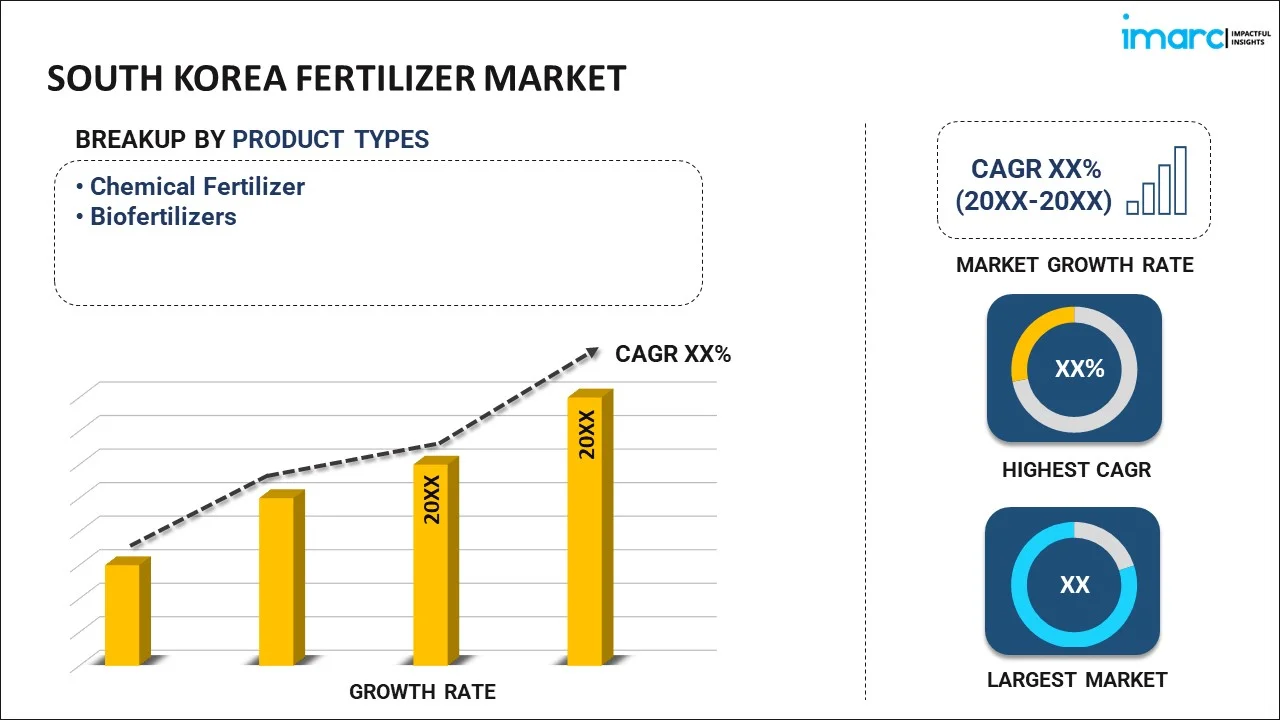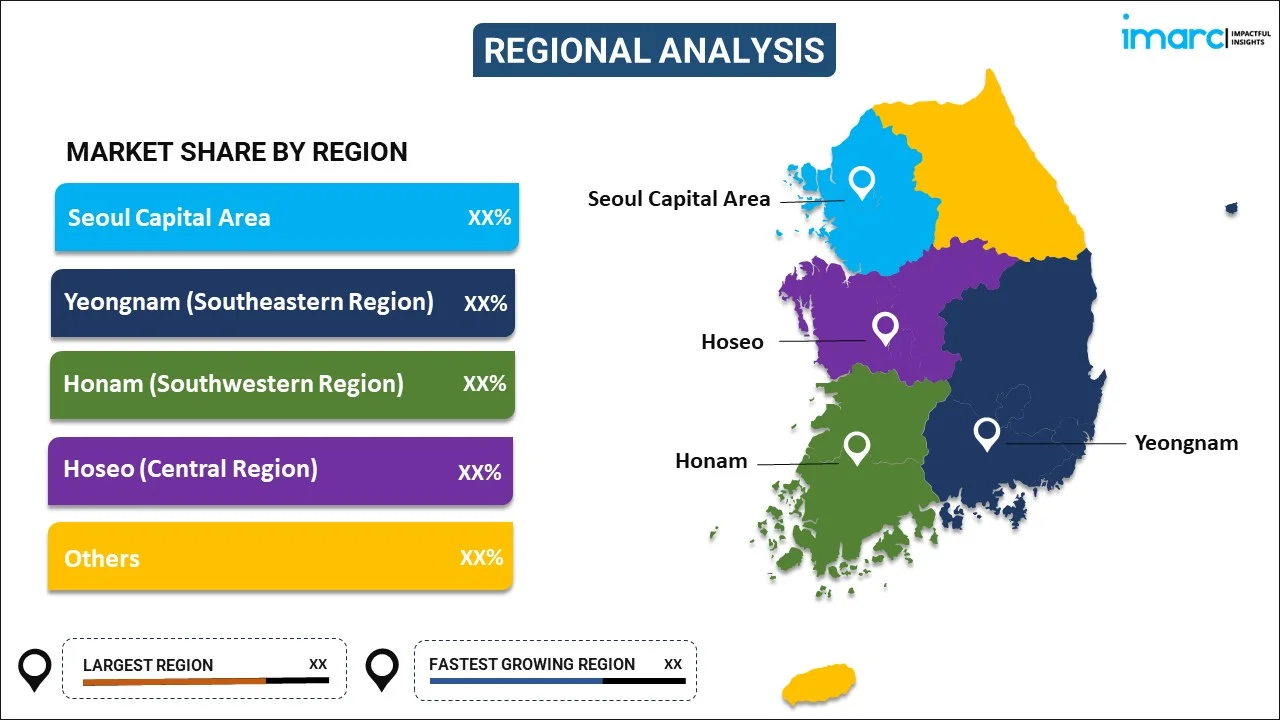
South Korea Fertilizer Market Report by Product Type (Chemical Fertilizer, Biofertilizers), Product (Straight Fertilizers, Complex Fertilizers), Product Form (Dry, Liquid), Crop Type (Grains and Cereals, Pulses and Oilseeds, Fruits and Vegetables, Flowers and Ornamentals, and Others), and Region 2025-2033
Market Overview:
South Korea fertilizer market size is projected to exhibit a growth rate (CAGR) of 4.20% during 2025-2033. The increasing focus on agricultural expansion, recent innovation in fertilizer formulations, imposition of supportive policies and subsidies by the government, ongoing shift towards organic farming, and rapid changes in climate patterns represent some of the key factors driving the market.
|
Report Attribute
|
Key Statistics
|
|---|---|
|
Base Year
|
2024 |
|
Forecast Years
|
2025-2033
|
|
Historical Years
|
2019-2024
|
| Market Growth Rate (2025-2033) | 4.20% |
Fertilizers refer to substances added to soil or plants to supply essential nutrients and enhance the growth, yield, and quality of crops. They are categorized into organic and inorganic types comprising compost, manure, and chemically synthesized fertilizers with specific nutrient concentrations. Fertilizers are widely used in agricultural activities for enhancing soil fertility, increasing crop yield, improving plant growth, aiding in seed germination, balancing soil pH, augmenting the quality of produce, reducing soil erosion, aiding in water conservation, improving pest resistance, and promoting healthy root development. They offer several benefits, such as increased agricultural productivity, economic growth, food security, environmental protection, efficient land use, and enhanced market competitiveness. In addition, fertilizers are known for their cost-effectiveness, ease of application, immediate nutrient availability, customizable formulations, and adaptability to various crop types and soil conditions.
South Korea Fertilizer Market Trends:
The increasing focus on agricultural expansion is facilitating the demand for fertilizers to enhance crop yield and quality. Additionally, recent innovations in fertilizer formulations and application technologies, which improve efficiency and effectiveness, are propelling the market growth. Besides this, the imposition of supportive policies and subsidies by the government encouraging sustainable agriculture practices is stimulating the market growth. Furthermore, the rising demand for South Korean agricultural produce across the globe, boosting the application of fertilizers for better crop quality, is acting as another growth-inducing factor. In addition, the ongoing shift towards organic farming, which increases the demand for organic fertilizers, is favoring the market growth. Apart from this, the introduction of strict environmental policies encouraging the use of eco-friendly and efficient fertilizers is fueling the market growth. Moreover, rapid changes in climate patterns, which necessitate the use of specialized fertilizers to maintain crop productivity, are bolstering the market growth. Along with this, the recent investment in research and innovation for developing novel fertilizers with enhanced properties is driving the market growth. Additionally, the increasing consumer awareness about health and environmentally safe food, which escalates the demand for organic and sustainable farming inputs, is strengthening the market growth. Furthermore, the growing awareness about soil health and the need for nutrient management is positively influencing the market growth. Besides this, the expanding logistics and distribution networks, which improve the availability of fertilizers, are accelerating the market growth. In addition to this, the rising crop prices, incentivizing farmers to use fertilizers for improved yield and profit margins, are providing a considerable boost to the market growth. Moreover, the escalating popularity of bio-fertilizers due to their environmental and economic benefits is favoring the market growth.
South Korea Fertilizer Market Segmentation:
IMARC Group provides an analysis of the key trends in each segment of the market, along with forecasts at the country level for 2025-2033. Our report has categorized the market based on product type, product, product form, and crop type.
Product Type Insights:

- Chemical Fertilizer
- Biofertilizers
The report has provided a detailed breakup and analysis of the market based on the product type. This includes chemical fertilizer and biofertilizers.
Product Insights:
- Straight Fertilizers
- Nitrogenous Fertilizers
- Urea
- Calcium Ammonium Nitrate
- Ammonium Nitrate
- Ammonium Sulfate
- Anhydrous Ammonia
- Others
- Phosphatic Fertilizers
- Mono-Ammonium Phosphate (MAP)
- Di-Ammonium Phosphate (DAP)
- Single Super Phosphate (SSP)
- Triple Super Phosphate (TSP)
- Others
- Potash Fertilizers
- Muriate of Potash (MoP)
- Sulfate of Potash (SoP)
- Secondary Macronutrient Fertilizer
- Calcium Fertilizers
- Magnesium Fertilizers
- Sulfur Fertilizers
- Micronutrient Fertilizers
- Zinc
- Manganese
- Copper
- Iron
- Boron
- Molybdenum
- Others
- Nitrogenous Fertilizers
- Complex Fertilizers
A detailed breakup and analysis of the market based on the product have also been provided in the report. This includes straight fertilizers [nitrogenous fertilizers (urea, calcium ammonium nitrate, ammonium nitrate, ammonium sulfate, anhydrous ammonia, and others), phosphatic fertilizers (mono-ammonium phosphate (MAP), di-ammonium phosphate (DAP), single super phosphate (SSP), triple super phosphate (TSP), and others), potash fertilizers (muriate of potash (MoP) and sulfate of potash (SoP)), secondary macronutrient fertilizers (calcium fertilizers, magnesium fertilizers, and sulfur fertilizers), and micronutrient fertilizers (zinc, manganese, copper, iron, boron, molybdenum, and others)] and complex fertilizers.
Product Form Insights:
- Dry
- Liquid
The report has provided a detailed breakup and analysis of the market based on the product form. This includes dry and liquid.
Crop Type Insights:
- Grains and Cereals
- Pulses and Oilseeds
- Fruits and Vegetables
- Flowers and Ornamentals
- Others
A detailed breakup and analysis of the market based on the crop type have also been provided in the report. This includes grains and cereals, pulses and oilseeds, fruits and vegetables, flowers and ornamentals, and others.
Regional Insights:

- Seoul Capital Area
- Yeongnam (Southeastern Region)
- Honam (Southwestern Region)
- Hoseo (Central Region)
- Others
The report has also provided a comprehensive analysis of all the major regional markets, which include Seoul Capital Area, Yeongnam (Southeastern Region), Honam (Southwestern Region), Hoseo (Central Region), and Others.
Competitive Landscape:
The market research report has also provided a comprehensive analysis of the competitive landscape in the market. Competitive analysis such as market structure, key player positioning, top winning strategies, competitive dashboard, and company evaluation quadrant has been covered in the report. Also, detailed profiles of all major companies have been provided.
South Korea Fertilizer Market Report Coverage:
| Report Features | Details |
|---|---|
| Base Year of the Analysis | 2024 |
| Historical Period | 2019-2024 |
| Forecast Period | 2025-2033 |
| Units | Million USD |
| Scope of the Report | Exploration of Historical and Forecast Trends, Industry Catalysts and Challenges, Segment-Wise Historical and Predictive Market Assessment:
|
| Product Types Covered | Chemical Fertilizer, Biofertilizers |
| Products Covered |
|
| Product Forms Covered | Dry, Liquid |
| Crop Types Covered | Grains and Cereals, Pulses and Oilseeds, Fruits and Vegetables, Flowers and Ornamentals, Others |
| Regions Covered | Seoul Capital Area, Yeongnam (Southeastern Region), Honam (Southwestern Region), Hoseo (Central Region), Others |
| Customization Scope | 10% Free Customization |
| Post-Sale Analyst Support | 10-12 Weeks |
| Delivery Format | PDF and Excel through Email (We can also provide the editable version of the report in PPT/Word format on special request) |
Key Questions Answered in This Report:
- How has the South Korea fertilizer market performed so far and how will it perform in the coming years?
- What has been the impact of COVID-19 on the South Korea fertilizer market?
- What is the breakup of the South Korea fertilizer market on the basis of product type?
- What is the breakup of the South Korea fertilizer market on the basis of product?
- What is the breakup of the South Korea fertilizer market on the basis of product form?
- What is the breakup of the South Korea fertilizer market on the basis of crop type?
- What are the various stages in the value chain of the South Korea fertilizer market?
- What are the key driving factors and challenges in the South Korea fertilizer?
- What is the structure of the South Korea fertilizer market and who are the key players?
- What is the degree of competition in the South Korea fertilizer market?
Key Benefits for Stakeholders:
- IMARC’s industry report offers a comprehensive quantitative analysis of various market segments, historical and current market trends, market forecasts, and dynamics of the South Korea fertilizer market from 2019-2033.
- The research report provides the latest information on the market drivers, challenges, and opportunities in the South Korea fertilizer market.
- Porter's five forces analysis assist stakeholders in assessing the impact of new entrants, competitive rivalry, supplier power, buyer power, and the threat of substitution. It helps stakeholders to analyze the level of competition within the South Korea fertilizer industry and its attractiveness.
- Competitive landscape allows stakeholders to understand their competitive environment and provides an insight into the current positions of key players in the market.
Need more help?
- Speak to our experienced analysts for insights on the current market scenarios.
- Include additional segments and countries to customize the report as per your requirement.
- Gain an unparalleled competitive advantage in your domain by understanding how to utilize the report and positively impacting your operations and revenue.
- For further assistance, please connect with our analysts.
 Inquire Before Buying
Inquire Before Buying
 Speak to an Analyst
Speak to an Analyst
 Request Brochure
Request Brochure
 Request Customization
Request Customization




.webp)




.webp)












